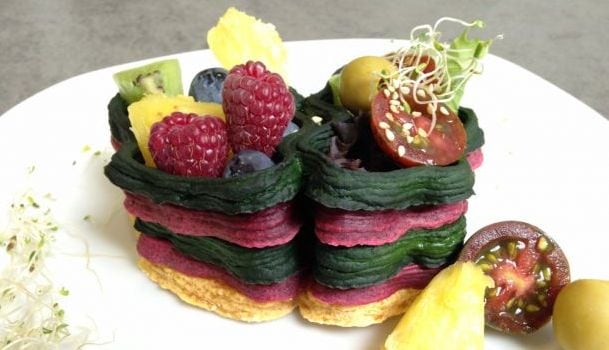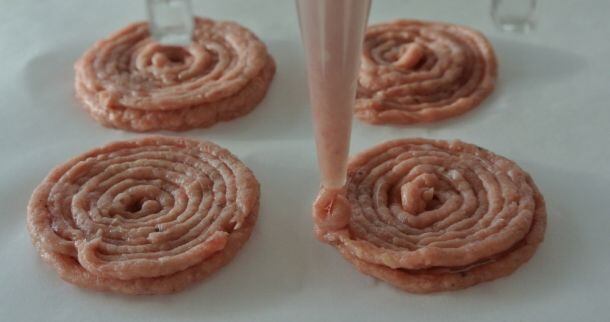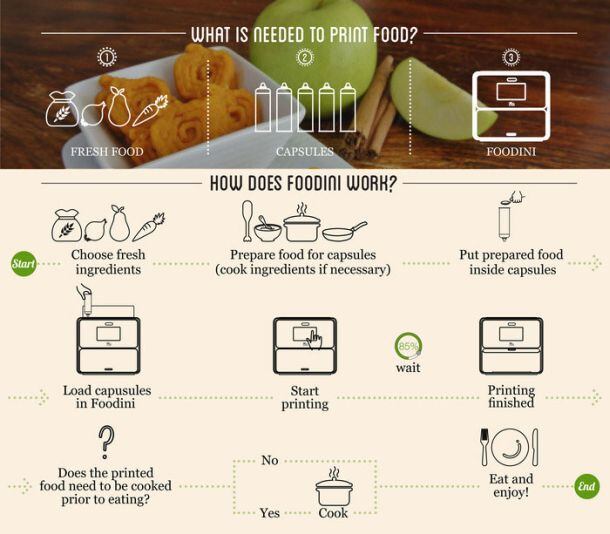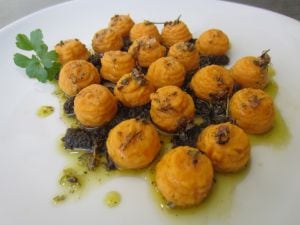“This is not a novelty product,” said Natural Machines co-founder Lynette Kucsma, who is preparing to ship the first wave of Foodini 3D printers to professional chefs and other customers in Q1, 2016 (with a price tag of around $1,500), but says the next generation of printers - which will likely be able to cook as well as print your food - will target the home cook.
“We are trying to solve a food problem, not taking a technology and see what cool things we can do with it,” stressed Kucsma, an American who is based in Barcelona, Spain, but says customers in more than 80 countries have expressed an interest in her printers - with the US expected to be one of the biggest potential markets.
Not just a one-trick pony
It’s also not just a one-trick pony, she told FoodNavigator-USA: “The Foodini is a kitchen appliance that helps you make fresh foods with fresh ingredients; it’s not a narrowly focused appliance like a bread maker or pasta maker. But it’s also not something you would necessarily use to make every part of a meal, just as when you’re cooking dinner you might have something on the stove, something in the oven and so on.
“It’s like we’ve taken a food manufacturing facility and shrunk it down to the size of a box that fits on your kitchen counter. But it’s not the Star Trek replicator yet and it’s not designed for every type of food.”
Besides, she added: “We’re not envisioning a future where everything you eat is 3D printed.
“Unlike other machines on the market the Foodini is also designed to connect to other devices, whether it’s your fit-bit – so you stop printing once you hit 800 calories, because that’s how much you burnt off on your run - or to the internet so you can find recipes.”

3D food printing has to be fast
But once the novelty of being able to print a cookie or ravioli wears off, won’t consumers start to wonder whether it might just be easier to cut them out from a sheet of cookie dough or whip open a packet of chilled filled pasta (which also boasts no additives or preservatives) and throw it into a saucepan?
“No one is going to wait hours for dinner so 3D printing has to be fast – and we can print crackers in 20 seconds, ravioli in two minutes and a pizza in 5 minutes – but we’re not saying it’s the fastest way to make food,” said Kucsma.
“The fastest way is to rip open a box and put it in the microwave, but what we are trying to do is get people back into their kitchens using real ingredients and Foodini is a good way to do that.
“And if you’re a chef and you have to make breadsticks in the shape of trees for 200 people, Foodini can do that for you, while you get on with something else on your list.
“To get mass market penetration, however, I think you’ll need the ability to cook, so we’re developing a cooking system now and our early testing is looking very positive. It takes away a lot of the pain points around printing, and I think it will be a game-changer in the market.”

The mush factor…
So how does it actually work?
First you choose a recipe from the touchscreen or your PC – or make up your own. Foodini then offers instructions for ingredients that should be prepared and placed in its reusable capsules (Kucsma is also working with food manufacturers and retailers to produce prefilled capsules).
Dr Anshul Dubey, a senior manager in PepsiCo's global snacks R&D division, told delegates at the IFT show over the summer that he saw potential in using 3D printing for rapid prototyping (optimizing the design of a wavy potato snack), or for quickly creating parts for machines such as extruders to test new snacking concepts and designs rather than something that might necessarily be used to mass-produce the finished food product itself
Next, you have to ensure the food is of the right consistency such that it can be printed – which means you might have to blend your chickpeas or cookie dough into a slurry before you can put it in the capsules (there are five in the first machine) – which isn’t super convenient.
But it’s not a deal breaker, insists Kucsma. “It’s like a food processor – some things work some things don’t. You can print a variety of textures, but you’re not going to 3D print a steak or a salad.
“It can’t be too watery as it will drip through the capsule system and it can’t be too chunky or the bits will clog up the nozzle but we can print things like couscous and it doesn’t have to be like baby food.
“We also envision in the future that the range of textures that are possible will increase.”

From day one we designed the Foodini to be easy to clean
But isn’t trying to get foods to just the right consistency to work in the printer going to frustrate early users? Perhaps, she said, “But the first wave of users – some of whom are Michelin starred chefs – is going to give us a lot of feedback. Once it gets to the consumer market it will be a much more tried and tested product.”
There will also be plenty of tried and tested recipes available on the machine to help people get started, she said: “Once you get used to it you’ll throw away the manual and do your own thing. Because it’s connected to the internet, users can also talk to other users and find out what works and what doesn’t.”
As for cleaning, she said: “From day one we designed the Foodini to be easy to clean. It’s also made with kitchen safe materials, and we do not use a syringe system or an excavation system, our food goes through dishwasher-safe stainless steel capsules through a nozzle and that’s it."
Mass customization

Speaking at Food Vision USA in Chicago on Thursday, Dr Hod Lipson from Columbia University said 3D food printing was getting “faster, cheaper, and better” by the day.
Dr Lipson said 3D printing was exciting because it could deliver mass customization, or “infinite variety, on demand” without increasing costs or requiring specialist skills, something unique in the food industry, or indeed any industry.
It also offered the promise of “extensive nutritional control” by enabling end users to create customized meals and products at the touch of a button, he said.
“The potential will be using its unique capabilities to do something new, something that we can’t do now. To make things that would be impossible to fabricate using conventional technology.”
Prices, meanwhile, have dropped from tens of thousands to less than a thousand dollars for 3D printing machines, and we can now print with everything from pasta and cheese, to chocolate, sugar paste, cookie dough and chickpeas, he said.
As for the new skills needed to design complex 3D objects, it may be that in future, with advances in artificial intelligence, we can simply tell our computers what we need, and get them to figure out how to do it, he said.
"I think that food printing might just be the killer app for 3D printers that no one could forsee."
VC firms like 3D food printing, but they don’t know how to value it
Natural Machines was launched in November 2012, and has attracted investment from the manufacturer of the machines, said Kucsma, who is about to embark on a fresh investment round.
So are venture capital firms falling over themselves to fund her venture, or has it been a hard sell?
According to Kucsma, “There’s a lot of excitement and buzz in the market around this technology but also a lot of unknowns. People understand it and they get it but they don’t know how to price it and value it so it is a bit of a grey area. People are nervous about jumping in at the deep end.”

Food is the killer app for 3D printing
So where does she see the technology going from here?
“Like any technology there will be a range of different products and price points to meet different needs in the future,” she predicted. “But I really think food will be the killer app for 3D printing.
“The key is getting the hardware right as the software can be updated at any time.”
The images are all courtesy of Foodini.
